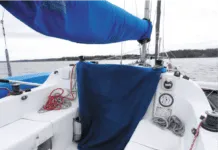
A significant amount of effort has been given to the development of life jackets that sailors will wear. The latest inflatable life jackets often include a harness and help keep a sailor tethered to the boat. If they do go overboard, the PFD theoretically delivers the buoyancy needed to keep the victim afloat and visible—expediting a rescue.
However, there’s one potential usage that’s had much less scrutiny. It’s a hazardous self-rescue scenario that arises in certain types of abandon ship incidents. These situations often define the pathway to safety as a gauntlet run through breaking surf, and an inflatable PFD may not be your best bet. Our review of some of the tragic sailing accidents of the last decade reinforces this concern.
One of these tragic accidents involved the crew of the 32 foot sloop Uncontrollable Urge. A cascade of problems began to unfold when the race boat’s rudder blade sheared away from the stock. It was late afternoon and the northern end of San Clemente Island was growing larger and larger. The crew tried to steer using sail trim augmented with propeller thrust. It didn’t work. Next came efforts to make up an emergency rudder and finally, in desperation, two light anchors were deployed. All attempts to regain control failed and a long overdue Mayday call to the Coast Guard was finally transmitted. It would take a helicopter over an hour to reach the scene. But just as the sun was setting, the sloop and her six person crew, entered the surf zone at the northern end of the island.
Uncontrollable Urge was driven hard onto a rocky offshore ledge. A particularly large set of waves hit like a piledriver, knocking the boat flat and causing the rig to collapse around the crew. Four sailors were swept overboard (three carried away by the current). The fourth, with his harness connected to the boat, was washed into the water but remained tethered alongside, tangled in the rigging. An attempt to haul him aboard failed and he was cut free to swim for shore. The two crew remaining aboard would soon have to decide whether to stick with the vessel being demolished around them, or abandon ship.
In the minutes that followed, five of the six crew would stagger ashore. All wore inflatable PFDs but four of the five survivors indicated that, in the surf zone, the life jacket bladders tried to shift position, causing both lobes of the bladder to attempt to relocate to the same side of their head. The sailor who tragically perished was found with his inflatable vest shifted into this position. Several of the crew said that making it to shore had been a very close call.
The last two sailors to abandon ship put a large rectangular foam fender to good use. It added extra buoyancy and helped significantly in getting them to shore safely. Another crew member was able to make his way to the inflated life raft that had torn free during the knockdown. He clung to the raft’s exterior and washed his way onto the rocky beach.
In the follow-on scrutiny of the incident, the life jacket manufacturer stated that their offshore rated inflatable vests were never intended for such use. This raises a major question regarding what should be worn, or used as a life jacket, when it’s time to abandon ship and the surf zone is the only shortcut to safety?
Such encounters are not unheard of. Three similar sailing accidents quickly come to mind. They involve the vessels, Low Speed Case (see Inside PS blog, “U.S. Sailing Releases Report on Farallones Accident”), Aegean and the big 66 foot sloop PWC. In total, 10 sailors perished in these encounters, all attempting to make their way from a grounded vessel to the nearby shore.



































